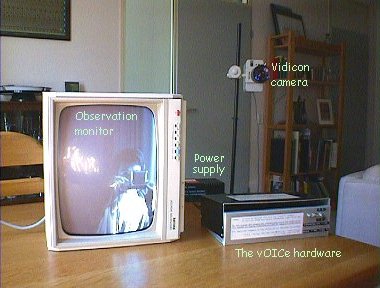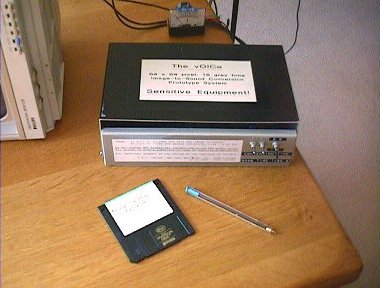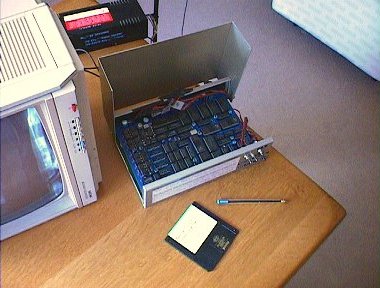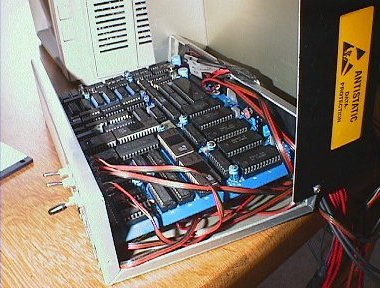
| 
|

| 
|
| The vOICe experimental set-up. | |
The vOICe original auditory display hardware only exists as a prototype, consisting of a black metal box measuring about 25 × 16 × 7 cm, receiving input from a commercial Philips vidicon observation camera and generating output for headphones - or back to the loudspeaker of the observation monitor that is part of the experimental set-up as shown here:

| 
|

| 
|
| The vOICe experimental set-up. | |
The pipelined parallel computer in The vOICe hardware prototype synthesizes soundscapes in real-time through DSP techniques. The parallel processing within the 5-stage pipeline gives the performance level needed for real-time sensory substitution. The hardware formed the basis for a scientific publication in the IEEE Transactions on Biomedical Engineering.
Although one could be tempted to make a new device look like high-tech fancy technology, such as in the headset shown below, this will probably be unacceptable to many blind people. Most of them hate to attract attention that relates to their visual condition, and it may be better to have a more neutral appearance in the form of an unobtrusive walkman-style device. Carrying a portable MP3 player or CD player while wearing headphones in the street is already so commonplace that no one really notices it. A similarly designed ``vOICeMan'' is currently more likely to be in line with the blind's legitimate requirements w.r.t. their physical appearance. No helmets, no Star-Trek-type visors a la Geordi LaForge, no strange goggles, no beeps and whistles observable to others, just a little hand-held box and headphones. Alternatively, since a head-mounted device is preferred for better coordination, posture and gait, one could hide the small camera in more regular looking headphones or inside a hat: in a sense, acceptance may relate to stealth technology like the use of "spy cameras" to avoid a cyborg appearance.

See also the software-based wearable computer implementation using The vOICe for Windows for devices running Microsoft Windows, or the smartphone version The vOICe for Android.
Design note on the "bionic eyes for the blind" prototype head-mounted camera setup
("wearable webcam") as depicted above was constructed from a Creative Labs Video
Blaster® webcam and a UNION Reality UR Gear® headset. The credit for designing
the individual components therefore goes to these respective companies.